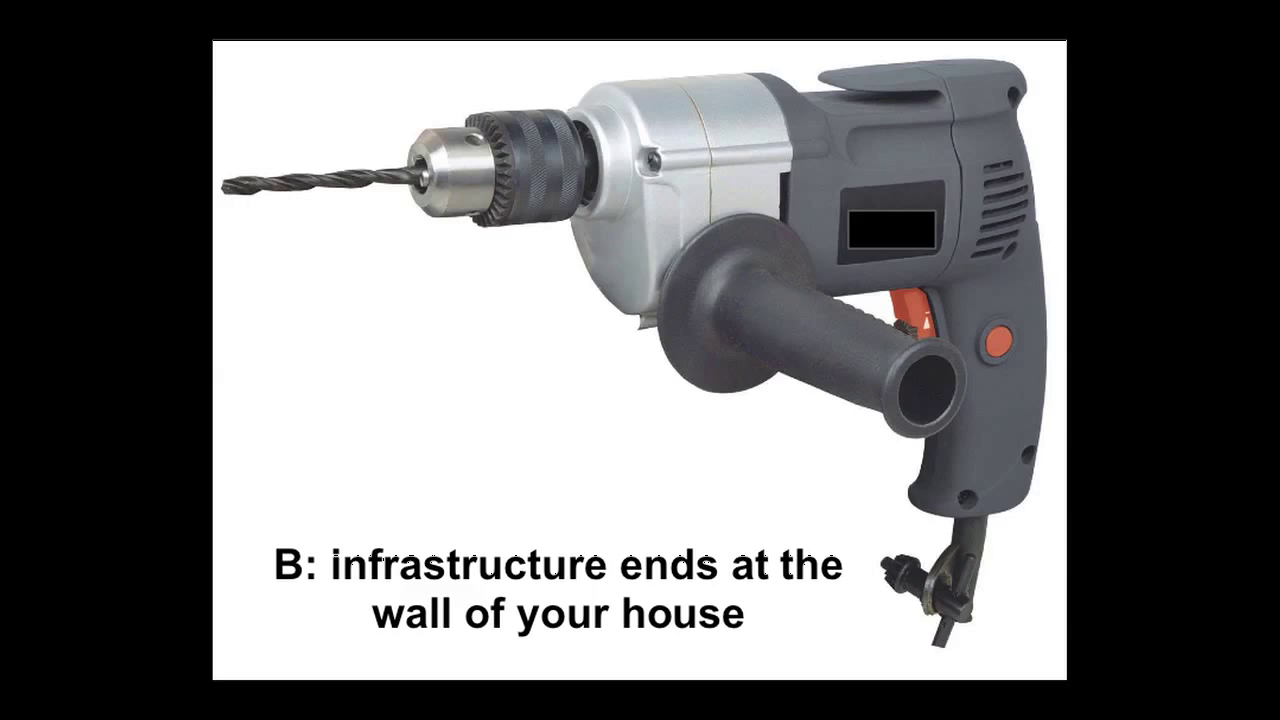Can everyone hear me. Good afternoon. Thanks very much all for coming out. Thanks to Lighthouse for having me.
I have spent the last year or so trying to explain to infrastructure engineers why they should care about the arts, critical theory, literature, design fiction, so on and so forth. Today I get to kind of flip the script and talk to artists, critical thinkers, and design fictioneers about why you should care about infrastructure. And just to completely derail what Simon [Ings] just said, infrastructure fiction is not a literary movement, it is more a sort of general manifesto of, “Hey, wake up.”
the illegibility of infrastructure
In Douglas Adams’ Life, the Universe and Everything, Arthur Dent and Ford Prefect are watching a test match at Lord’s when a spaceship built, as I recall, to resemble a small Italian bistro inexplicably turned on its side lands on the ground in the midst of an over. Not a person notices it but Ford and Arthur, both seasoned and cynical galactic hitchhikers. That’s because the spaceship is protected by what’s called a Someone Else’s Problem Field, whose inventor realized that while making something invisible is incredibly difficult, making something appear to be someone else’s problem is very, very easy.
You can think of this as the flip side of the dubious nudge psychology that Mr. Cameron’s policy unit is so fond of, if you like. The Someone Else’s Problem Field around infrastructure is, ironically enough, a measure of infrastructure’s ubiquity and success. You don’t think about infrastructure because you don’t need to. It just works. And when it doesn’t, there’s a phone number you can not bother calling, because they’ll only put you on hold anyway, and by the time you get through it’ll probably have fixed itself, so why bother? You pay for these things to work, and complaints aside as much as we like to carp about it all, most of the time they do. You pay for them to be someone else’s problem.
Being reminded of infrastructure is rarely pleasant. It’s no fun to turn your tap and have nothing come out. It’s a different sort of not fun when you discover that a wind farm, town bypass, or high-speed train line is scheduled to materialize near your house, or when protestors camp out on your driveway to fight a fracking company.
Infrastructure is meant to make life easier, not harder. The better it gets at the former, the more painful are the moments when it does the latter. The golden age of British infrastructure was surely the Victorian era, thanks to a combination of ambition, new technological developments, and an eminently exploitable underclass work force. In those days infrastructure primarily benefited the middle and upper classes. If you were working class you were likely one of infrastructure’s many unsung human components, and new infrastructure was more likely to spoil your environment than improve it. To the middle classes, though, infrastructure, especially the railways, was progress incarnate. A living force in the world. Victorian painting and literature is full of infrastructure, sometimes as hero, sometimes as villain, depending on the target audience. Majestic bridges in oil on canvas for the gallery gala, train wreck penny dreadfuls for the proles. It was all new, and people wondered what it meant.
design fiction and reflexive macroengineering
Speaking earlier this year, Anab Jain of Superflux, who was kind enough to publish the essay upon which this talk is based described design fiction as follows:
These projects bypass the established narratives about the present and future that create the hypnosis of normality, and in doing so, allow for an emotional connection with the raw weirdness of our times, opening up an array of possibilities.
Anab Jain, Design for the New Normal (Revisited) [404; new]
It’s the best and most concise description that I’ve yet found of what design fiction does. How design fiction does what it does, on the other hand, is a much more open question. Its techniques emerge from the mediums it makes use of. So, we might perhaps wink at McLuhan’s ghost and say that the medium is the method. Design fiction can be written, it can be still images on mockup pack shots, a fake promo spot or mock documentary video, or even performance theater, or live action role play. I don’t know if there are yet any design fiction computer games, but I wouldn’t be at all surprised if someone tells me there are.
The main requirement, it seems to me, is that in order to be effective, design fictions must believe in themselves, though there are some tricky caveats on that that I’ll come to later on. But for now, the point is that putting together a project proposal for some wacky new idea is not enough. If you present a design fiction as a proposal, you give your audience to say, “That’ll never make it to market.” which ends the conversation instantly. You might as well try feeding social metaphors to hard science fiction fans. So you don’t propose a solution to the problem. No, in a design fiction, you imagine the problem to already be solved, and then you ask what that solution has to say about the problem that you hadn’t thought about before, and what it tells you about the future in which it might actually get built.
Asking what an object or structure means is an intrinsic part of what designers, architects, and artists do all the time. It’s not natural for engineers at all. Engineers are practical people. They build things to spec, they keep lights on, they keep the trains running. To be clear, this is not to claim that engineers have no imagination; far from it. A surprising amount of science fiction readership are engineers as well. Engineers have plenty of imagination, but it is directed very differently. Engineers solve problem, they imagine how. The artists, by contrast, imagines why. The engineer’s problem is the end product of the artistic process.
(re)defining boundaries
Before we can ask what infrastructure means, however, we need to first determine what infrastructure is. We need to define it, we need to sketch out the field of inquiry. The Institution of Civil Engineers define infrastructure as “the physical assets underpinning [the UK’s] networks for transport, energy generation and distribution, electronic communications, solid waste management, water distribution and wastewater treatment.” Exciting stuff, right? This purely materialistic conception of infrastructure, so useful for an engineer, gets the rest of us everywhere and nowhere at once because it hides the social impact of infrastructure behind functional generalities. To reveal that social impact, we have to destroy two very important assumptions.

Assumption A: Infrastructure enables technology. A designer will usually take infrastructure as a given, if they think of it at all. Just a set of standards and protocols upon which they can rely to support certain functionalities in their designs. Infrastructure is the oxygen of the design profession, if you like. Always invisibly ready to breathe life and capability into the designer’s creations. Assumption A isn’t so much wrong as it’s incomplete. It assumes a simple “Y follows X” causality. If infrastructure, then technology. But the reality, as reality often is, is more complex.
Of course infrastructure does enable technology, but technology has at the same time been a major driving force in the development, expansion, enhancement, and ubiquity of infrastructure. Infrastructure and technology have always been locked in a symbiotic co-evolution to the extent that the division implied by the separate terms is in fact largely illusory. Infrastructure and technology are two sides of the same coin, if you like. But infrastructure is the ugly, boring, and pragmatic side, while technology is flashy, exciting, and transformative. Consider Edison, arguably most famous for the invention of the incandescent light bulb. We tend to forget that Edison and the other electrical inventors of his time were struggling to crack the light bulb problem in order that they had a product with which they might convince people that they should get connected to the early electricity supplies. The light bulb concretized the potential of electricity to do useful work in the home, turning what had up til then been an abstract and rather frightening scientific discovery into a household utility. And the rest is quite literally history.

Assumption B: Infrastructure ends at the wall of your house. Assumption B is as far as I can tell a sort of late-stage mutation of Marxist commodity fetish in that it manifests as the erroneous notion that the value and utility of a technological object is located entirely within the object itself. Take this power drill. Fairly standard household tool for most of us, I think. Or at least for most households, anyway. If I was to ask you what a power drill can do, you might say to me, “That’s obvious, Paul. It can drill holes in your walls, can’t it?” Well, actually, no. The drill bit, the pointy bit, for people who don’t know the structure of drills, which I’m assuming isn’t that many of you. The drill bit is the bit that drills the holes in your walls. That is the tool there, that little bit, the black pointy bit at the left-hand side. The rest of it, the motor unit, the plastic handle, so and so forth, the cable, the motor unit of the power drill simply enables you to use the drill bit to make more holes more quickly before you get tired, and through a greater variety of materials than you could drill through using your own elbow grease.
The drill bit is the tool. The power drill is a function-specific extension of the infrastructure, an interface between the drill bit and the abstract world of harnessed energy. When you connect a device to an infrastructure, the latter is effectively subsumed by the former. To use a literary term, it’s a sort of metonymy. The power and potential that we imply when we speak of a power drill is actually the power and potential of the electricity grid, an electrical spirit that animates the drill’s unliving body. The power drill is neither tool nor infrastructure. It is quite literally something in between.
You don’t believe me? Unplug the power drill from the wall and take it somewhere there are no wall sockets or even just the wrong sort of wall sockets. Or take a power shower to someplace without a water distribution mains, or your smartphone to somewhere there’s no signal coverage. Not much use to you now, is it?
This constructive disillusionment is what infrastructure fiction should aim to achieve. It must problematize not just the discrete technology or service, but the entire infrastructural stack on which the technology or service is dependent. Infrastructure fiction must collapse the Someone Else’s Problem Field, finger-snap you out of Anab’s hypnosis of normality. It must reveal the hidden meta-system that underpins everything you do.
It’s all well and good to shatter illusions, but infrastructure fiction should also present alternatives, substitute visions. (And those of you who are doing the conference Bingo card, Bruce Sterling mention coming up here.) Bruce Sterling talks a lot about bad forms of design fiction and makes the point that design fiction shouldn’t be hoax‑y, deceitful or packed with FUD: Fear, Uncertainty, and Doubt. As I said earlier, design fiction must believe in itself to do its work. But it must simultaneously signal its fictionality, however subtly. This is, not at all incidentally, the central challenge to writing good science fiction, and the reason why airport techno-thrillers can feel less believable than an out-and-out science fiction novel. The latter is almost always winking at the audience while the former tries to pass for realism and thus falls into fiction’s equivalent of the Uncanny Valley.
It isn’t just a matter of literary aesthetics, though. Sterling is seeking an ethical dimension to design fiction because he knows first-hand the power of the techniques he’s discussing and he’s cynical enough to know that powerful techniques work just as well in bad hands as good ones. The term “diegetic prototype” was coined by David Kirby (who someone else trumped me to mentioning first) in a paper called “The Future is Now: Diegetic Prototypes and the Role of Popular Films in Generating Real-world Technological Development.” Kirby’s paper is a discussion of the way that technologists and designers are drafted into science fiction film production units so as to get the tech in the movie’s story-world looking convincing. But we’ve now reached a point where films are becoming a vehicle through which these designers can inject their design ideas into the cultural soup, acting as what Kirby calls “pre-product placement,” a particularly apposite term, given the touch-screen interfaces of Minority Report are a prime example and one of the ones he uses in that paper. I heartily recommend checking it out.
My colleague Scott Smith talks a great deal lately about “flat-pack futures,” especially those grotesquely aseptic lifestyle technology ads that are suddenly everywhere, showing clearly how the purchase of a certain branded piece of hardware will situate you in a blandly contemporary and impossibly unsmudged ideal of the middle-class Western lifestyle. There’s a crude sort of diegetic prototyping at work here, too. The difference between this stuff and proper design fiction is that flat-pack futures exchange the critique of technology for the uncritical advocacy of technology. The problem is that to Josephine Public the difference between foresight and marketing may not be immediately apparent, especially in a medium that relies on the internal coherence of false realities to do its work.
For example, one might make the argument that transhumanism is a great example of a very sophisticated and collaborative shared-world design fiction veneer over the top of a cynical me-first libertarian ideology which in turn obscures an elaborate Ponzi scheme based on cryogenic life insurance policies and unfalsifiable proposals for AI research grants. But as I don’t have a lawyer on retainer, I wouldn’t want to claim such a thing publicly.

However there’s a value even to flat-pack futures in that the biggest ones get a lot of public attention and hence a lot of public critique. It was very generous of Elon Musk to come out with a perfect example of flat-pack future infrastructure fiction so shortly after I coined the term. (Thanks, Elon. If you’re watching, the check is in the mail.) But really, the Hyperloop thing is a great example of design fiction accidentally done badly. For instance the locations that Musk’s proposal joined together made it very obvious that Elon Musk’s idea. customer is himself, in stark contrast to the PayPal user interface, whose ideal customer is presumably a human being of infinite patience. But screwy demography and market research, this instance of pinko, crypto-socialist proposal for improving the general human condition, this is serious Silicon Valley techno-shit, yeah? Blithely presented as a shovel-ready project just waiting for the right amount of venture capital to light the blue touchpaper, so stand well back ladies and gentlemen.
It’s also wrong in many, many ways. There weren’t quite so many robust critiques of Hyperloop as there were breathless fawning reblogs of the pretty pictures, but there were quite a few taking the idea to task from pretty much every angle possible: the geography, the economics, the materials, the engineering, the health and safety, so on and so forth.
beneath the street, the conduit!
I hope it’s clear now if it wasn’t from the start that “infrastructure fiction” is less a methodology (and with apologies to Simon, definitely not a literary movement) than a manifesto, a plea for a paradigm shift in how we think about our increasingly technology-saturated world. How exactly you take it on board, what exactly you do with it, will depend on who you are and what it is you do.
When I talk to my engineer colleagues about infrastructure fiction, I tend to pitch it as another sort of modeling. Engineers do a lot of modeling; not catwalk stuff, different sort of modeling. But it’s an almost purely qualitative and conceptual form of modeling by comparison to the models that engineers usually use. The tricky bit to get across to an engineer is that in design fiction, failure is not only instructive but actively desirable. Engineers rarely waste time thinking about something which they already know can’t be built, or won’t be built. This is the good thing about Musk’s Hyperloop. It got thousands of people thinking imaginatively and critically about infrastructure, talking about what it means, what it should do, and about how and for whom it should do those things.
You try having that conversation around High Speed 2, by contrast, and all anyone will then care about is how much it’s going to cost, who’s back garden it’s going to run through, who’s getting the back hand, and so on and so forth. HS2 is too real and political a problem, too rooted in the here and now for us to get to grips with the really big questions that surround it. By contract the imaginative and speculative bits of Hyperloop serve to dispel an Anab’s hypnosis of normality and open up the possibilities and pitfalls for discussion. And even if that’s all it achieves, I still think it’s done good work. I rather doubt Mr. Musk would agree with me on that point, however.
For artists, writers, designers, and theorists, and thinkers and all you other fascinating people out there infrastructure fiction is possibly best described as a call for you all to radically change the way you understand role of technology in your lives. To look afresh at the relationships between the things you do and the systems that make it possible for you to do them. One thing I want to make a really strong point about is that I am not asking you to “think outside the box.”
On the contrary, I want you to think exactly about the box. Infrastructure fiction is not about transcending constraints, it is about coming to terms with our constraints, not just individually but as a civilization. It is about understanding the nature of our constraints and internalizing the systemic limits that come from living in a social ecosystem with finite resources.
Nor do I want you to, as one response to my essay suggested, write more stories about bridges. Though if you’ve got a story to tell about bridges I think you should go ahead and tell it. The clue is in the name. Infrastructure fiction is obviously interested in infrastructure. But it’s fiction, and fiction is for and about people.
So, by all means write a story or draw a picture or make a video that involves a bridge, but make the bridge more than a prop, more than a setting or a symbol or a backdrop. Make it a character in its own right, an agent in the network of society in which it is a structural and functional component. But, write about people too, because they’re the most reliably invisible part of any infrastructure.
Not just the people who use it, but the people who maintain it, the people who operate it, the people who protest against it, the people who blow it up, or steal bits of it, even the people who live among its ruins. Write about the relationship that people have with that bridge, and that the bridge has with those people. Remember that neither makes sense in the absence of the other.
Think about the box. Think about constraints. Failure is instructive. Thank you.
Further Reference
Paul posted his script (not found until after this transcript was produced) at Futurismic. The word counts differ by ~500 words, however, so this is posted as reflecting the talk as presented.
The original version of Anab Jain’s Design for the New Normal.
